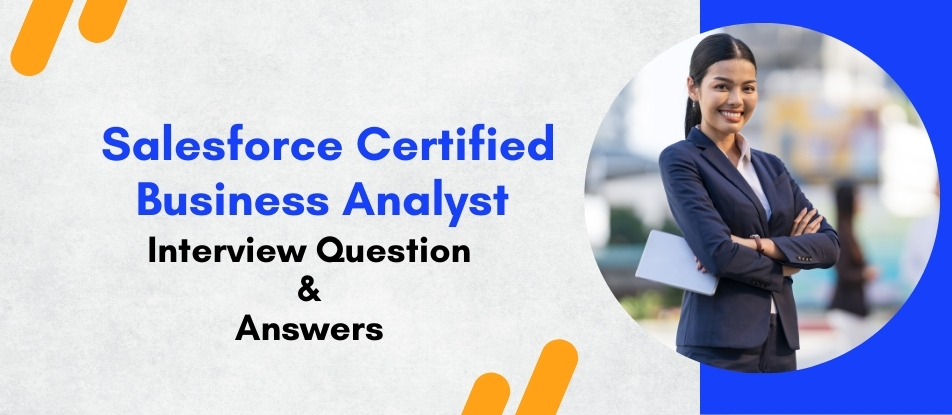
Salesforce Certified Business Analyst training is designed to build expertise in analyzing business needs and translating them into Salesforce-driven solutions. The course focuses on requirements gathering, stakeholder engagement, process optimization, and data-driven decision-making. Ideal for professionals aiming to bridge business and technology, it prepares candidates for the Salesforce Business Analyst certification and empowers them to contribute effectively to digital transformation initiatives.
Salesforce Certified Business Analyst Training Interview Questions Answers - For Intermediate
Q1: What are user stories, and why are they important in Salesforce projects?
User stories are short, simple descriptions of a feature told from the perspective of the end user. In Salesforce projects, they help define functionality in a user-centric way, making it easier for development teams to understand business needs. They are usually structured as "As a [role], I want [feature] so that [benefit]." Well-written user stories help prioritize work, facilitate collaboration, and support agile methodologies.
Q2: How does a Business Analyst support data migration in Salesforce implementations?
A Business Analyst supports data migration by identifying data sources, mapping legacy data to Salesforce objects, and validating data quality. They collaborate with technical teams to ensure accurate transformation and loading of data. Involvement also includes coordinating test cycles to verify integrity and completeness post-migration.
Q3: What is the purpose of a requirement traceability matrix (RTM)?
A requirement traceability matrix links requirements to their corresponding design, development, and test cases. It ensures that all business needs are addressed during implementation and helps track the status of each requirement. In Salesforce projects, RTMs are critical for maintaining visibility, reducing missed functionality, and supporting audits or compliance efforts.
Q4: How are personas used in Salesforce solution design?
Personas represent typical users and help in understanding their goals, pain points, and behaviors. Business Analysts use personas to tailor Salesforce solutions to real user needs. For instance, designing different user experiences for a Sales Manager vs. a Service Agent ensures higher adoption and satisfaction.
Q5: What is the role of a BA in change management during a Salesforce rollout?
A Business Analyst plays a key role in managing change by helping users transition from old processes to new ones. This includes creating training materials, conducting workshops, gathering feedback, and supporting communication plans. The BA ensures that the change is smooth, accepted, and aligned with business goals.
Q6: How can a Business Analyst contribute to improving Salesforce user adoption?
The Business Analyst drives user adoption by ensuring the solution is intuitive, relevant, and aligned with daily user tasks. They gather feedback, conduct usability testing, and identify barriers to usage. They also help design training programs and documentation tailored to different user groups.
Q7: What are validation rules in Salesforce, and why should a BA care about them?
Validation rules ensure data entered into Salesforce meets defined criteria. They prevent incorrect or incomplete data from being saved. Business Analysts need to understand and define these rules to uphold data integrity and ensure business processes flow correctly based on clean, accurate inputs.
Q8: Describe a use case where automation was recommended by a Business Analyst in Salesforce.
In a case where a sales team manually assigned leads, a Business Analyst proposed an automation solution using assignment rules and workflows in Salesforce. This change improved efficiency, reduced errors, and ensured leads were routed instantly to the right reps based on criteria like territory and product interest.
Q9: How does a Business Analyst handle custom vs. out-of-the-box solutions in Salesforce?
The Business Analyst evaluates whether business needs can be met with Salesforce's standard functionality. If not, they assess the impact and feasibility of custom development. Preference is always given to out-of-the-box features to ensure scalability, lower maintenance, and easier upgrades unless a unique process truly demands customization.
Q10: What is a sandbox in Salesforce, and how is it used in the BA lifecycle?
A sandbox is a testing environment in Salesforce that allows development and testing without affecting live data. Business Analysts use sandboxes to review configurations, validate requirements, and conduct UAT sessions. It enables safe experimentation and refinement of processes before moving changes to production.
Q11: How should a BA manage stakeholder expectations in a Salesforce project?
Stakeholder expectations are managed by setting clear, realistic goals and maintaining open communication. The BA provides regular updates, shares progress transparently, and addresses concerns early. Prototypes, demos, and visual models help stakeholders visualize outcomes and reduce misunderstandings.
Q12: What is the significance of Lightning Experience for Business Analysts?
Lightning Experience offers a modern UI and enhanced productivity features in Salesforce. Business Analysts need to understand its components—like Lightning App Builder and dynamic forms—to recommend better user experiences. They also play a role in planning transitions from Classic to Lightning for improved usability and functionality.
Q13: How does a Business Analyst use feedback from UAT in Salesforce projects?
Feedback from User Acceptance Testing (UAT) helps identify mismatches between user expectations and the delivered solution. The BA analyzes this feedback, logs issues or enhancement requests, and coordinates with the technical team to implement fixes. Incorporating this feedback ensures the solution is user-ready and aligned with requirements.
Q14: What is the role of KPIs in measuring the success of a Salesforce feature?
Key Performance Indicators (KPIs) are measurable values that demonstrate the effectiveness of a feature. Business Analysts help define relevant KPIs during planning—such as reduced case resolution time or increased lead conversion. Post-deployment, they monitor these KPIs to evaluate if the business goals are being met.
Q15: How can a Business Analyst contribute to Salesforce integration projects?
In integration projects, the Business Analyst defines data flow between Salesforce and external systems, identifies business rules, and ensures seamless communication across platforms. They work closely with integration architects and developers to validate mapping, test data synchronization, and ensure business continuity across systems.
Salesforce Certified Business Analyst Training Interview Questions Answers - For Advanced
1. How can a Business Analyst support Agile delivery in Salesforce projects?
A Business Analyst supports Agile delivery by acting as a bridge between the business stakeholders and the development team. They facilitate the creation of a well-prioritized product backlog, breaking down epics into user stories with clear acceptance criteria. By participating in sprint planning, daily stand-ups, reviews, and retrospectives, the Business Analyst ensures that the team remains aligned with evolving business needs. They play a vital role in clarifying requirements in real time, adjusting scope when priorities shift, and validating completed work against business objectives. Agile ceremonies are leveraged to promote transparency, foster collaboration, and deliver incremental value using Salesforce’s iterative development approach.
2. What is the role of a Business Analyst in managing regulatory compliance within Salesforce?
The Business Analyst is responsible for ensuring that Salesforce implementations comply with relevant regulatory standards such as GDPR, HIPAA, or SOX, depending on the industry and region. This involves working closely with legal, compliance, and security teams to identify regulatory requirements and translating them into system-level configurations, processes, and documentation. Key activities include data classification, audit logging, consent management, field-level security, and data retention policies. The Business Analyst also ensures that compliance requirements are incorporated into user stories and are validated through testing and stakeholder review, mitigating risk and ensuring legal alignment.
3. How should a Business Analyst define and manage personas in a Salesforce project?
Defining personas is an essential step in aligning Salesforce functionality with user needs. The Business Analyst develops personas based on user research, interviews, and behavioral data, capturing goals, pain points, motivations, and usage patterns. These personas guide the design of user interfaces, role-based permissions, workflows, and reports. Managing personas involves regularly validating them against real-world user behavior, especially in projects with diverse user groups. This approach ensures that solutions are user-centric, promote adoption, and deliver tailored functionality that meets the distinct needs of different user segments within the organization.
4. What strategies are used to drive user adoption after a Salesforce rollout?
Driving user adoption post-rollout requires a multifaceted strategy involving training, communication, feedback, and incentives. The Business Analyst works with training teams to create role-specific materials, such as manuals, video tutorials, and simulations. Early adopter programs and change champions are identified to promote peer influence. Gamification and recognition programs can be used to incentivize usage. Continuous support mechanisms, including help desks and in-app guidance tools, help address user concerns. Adoption metrics, such as login frequency, feature utilization, and data entry completeness, are monitored to refine the strategy and ensure sustained engagement.
5. How can a Business Analyst help optimize Salesforce for different business units within a large organization?
In large organizations with multiple business units, the Business Analyst plays a key role in balancing standardization with customization. This involves conducting stakeholder interviews and workshops to understand each unit’s specific needs while identifying common processes that can be centralized. The use of record types, page layouts, custom objects, and role hierarchies allows for tailored experiences within a shared Salesforce org. The Business Analyst ensures governance through the establishment of shared data models, consistent naming conventions, and clear documentation. This strategic coordination enables scalability and efficient cross-unit collaboration.
6. What techniques can be used to identify hidden requirements during Salesforce discovery sessions?
Identifying hidden requirements involves a combination of probing techniques, contextual observation, and process analysis. Techniques such as the 5 Whys, job shadowing, and journey mapping uncover pain points and inefficiencies that users may not explicitly state. Analyzing exception cases and edge scenarios often reveals overlooked needs. Reviewing current system usage, support tickets, and user feedback helps surface gaps. The Business Analyst also pays attention to non-verbal cues during interviews and validates assumptions through mockups and prototypes to uncover tacit requirements that are crucial for successful implementation.
7. Explain the significance of business value mapping in a Salesforce project.
Business value mapping connects Salesforce features and deliverables to measurable business outcomes. This process enables prioritization of features that offer the highest return on investment. By mapping user stories to KPIs such as customer retention, lead conversion rate, or operational efficiency, the Business Analyst ensures the project remains focused on delivering tangible value. This mapping also provides a foundation for post-implementation ROI analysis and justifies future investment in platform enhancements. Clear visualization of value streams helps engage stakeholders and align technology initiatives with strategic goals.
8. How can a Business Analyst collaborate with Salesforce Architects during solution design?
The collaboration between Business Analysts and Salesforce Architects ensures that business requirements are translated into scalable, secure, and technically feasible solutions. The Business Analyst provides detailed process flows, use cases, and functional requirements, which the Architect uses to propose system designs. Regular design review meetings are held to validate technical assumptions and ensure alignment with business needs. Together, they assess the impact of design choices on user experience, integration, data models, and future scalability. This synergy leads to a solution that is both user-centric and technically robust.
9. What is the importance of security and access control in Salesforce projects, and how is it handled?
Security and access control in Salesforce projects are crucial to protect sensitive data and enforce organizational policies. The Business Analyst collaborates with the security team to define user roles, profiles, permission sets, and sharing rules based on job functions and data sensitivity. Compliance requirements such as data residency and encryption standards are also considered. Role hierarchies and field-level security ensure that users access only relevant data, while audit trails provide accountability. A clear understanding of these mechanisms allows the Business Analyst to embed security into the design phase, reducing risks and ensuring regulatory compliance.
10. How should a Business Analyst document Salesforce requirement for system integrators or third-party vendors?
When working with system integrators or third-party vendors, a Business Analyst must produce clear, structured documentation that minimizes ambiguity. This includes functional requirement specifications (FRS), user stories with acceptance criteria, data flow diagrams, and integration specifications. Documentation should follow industry standards and include context such as business objectives, process overviews, constraints, and compliance requirements. Providing sample data, mockups, and use case scenarios further enhances clarity. A version control mechanism ensures that updates are tracked and communicated, promoting consistency and accountability throughout the development lifecycle.
11. What methods are used to assess process efficiency before and after Salesforce implementation?
To assess process efficiency, a Business Analyst employs a combination of baseline measurements, time-and-motion studies, and KPI tracking. Before implementation, current state metrics such as average task completion time, error rates, and process bottlenecks are recorded. After deployment, the same metrics are monitored to evaluate improvements. Tools like Salesforce reports, audit logs, and user behavior analytics help quantify changes. Process heat maps and workflow simulations can visually demonstrate efficiency gains. This analysis validates the impact of the Salesforce solution and provides data-driven insights for further optimization.
12. How does a Business Analyst ensure Salesforce integrations support business goals?
Ensuring that integrations support business goals requires the Business Analyst to define integration requirements with a focus on data accuracy, timeliness, and usability. This involves identifying source and target systems, mapping data fields, defining frequency and direction of data flows, and setting error-handling protocols. Business rules for transformations, filters, and validations are documented in detail. The Business Analyst ensures that integrations enable business functions such as real-time customer visibility, order fulfillment, or campaign performance tracking. Regular testing, monitoring, and stakeholder feedback loops are used to validate effectiveness post-integration.
13. What is the role of a Business Analyst in a Salesforce Center of Excellence (CoE)?
In a Salesforce CoE, the Business Analyst acts as a liaison between business units and the Salesforce delivery team, ensuring governance, standardization, and strategic alignment. Responsibilities include defining business process standards, maintaining requirement repositories, conducting impact assessments, and supporting innovation through reusable assets. The Business Analyst also facilitates knowledge sharing across teams, promotes adherence to best practices, and assists in backlog prioritization for the enterprise roadmap. This centralized role enhances consistency, reduces duplication, and accelerates value delivery from the Salesforce platform.
14. How can Salesforce Flow be leveraged to automate business processes, and what is the Business Analyst’s role?
Salesforce Flow enables automation of complex business processes without code by configuring logic through a drag-and-drop interface. A Business Analyst identifies manual, repetitive tasks or approval processes suitable for automation and translates them into process flows. They define inputs, decision criteria, and expected outcomes, often collaborating with administrators or developers to build and test the flow. Proper documentation and UAT ensure the flow performs as expected. This approach reduces manual errors, speeds up operations, and enhances user productivity, with the Business Analyst ensuring alignment with business needs.
15. Describe the process of creating a Salesforce roadmap and its benefits.
Creating a Salesforce roadmap involves aligning business strategy with platform capabilities over time. The Business Analyst collects input from stakeholders across departments, prioritizes initiatives based on business value and technical feasibility, and segments deliverables into short-term, mid-term, and long-term goals. The roadmap includes timelines, dependencies, risk assessments, and projected benefits. It is typically visualized using Gantt charts or product planning tools. The roadmap provides direction for Salesforce development, ensures resource alignment, manages stakeholder expectations, and supports continuous improvement based on evolving business needs.
Course Schedule
| Apr, 2025 | Weekdays | Mon-Fri | Enquire Now |
| Weekend | Sat-Sun | Enquire Now | |
| May, 2025 | Weekdays | Mon-Fri | Enquire Now |
| Weekend | Sat-Sun | Enquire Now |
Related Courses
Related Articles
Related Interview
- Proofpoint Email Security Interview Questions Answers
- Smart Plant Electrical Admin (SPEL) Interview Questions Answers
- Microsoft 365 Administrator Essentials (MS-102) Training Interview Questions Answers
- Dynamics 365: Supply Chain Management Functional Consultant Expert (MB-335) Training Interview Questions Answers
- Honeywell EPKS C300 DCS Training Interview Questions Answers
Related FAQ's
- Instructor-led Live Online Interactive Training
- Project Based Customized Learning
- Fast Track Training Program
- Self-paced learning
- In one-on-one training, you have the flexibility to choose the days, timings, and duration according to your preferences.
- We create a personalized training calendar based on your chosen schedule.
- Complete Live Online Interactive Training of the Course
- After Training Recorded Videos
- Session-wise Learning Material and notes for lifetime
- Practical & Assignments exercises
- Global Course Completion Certificate
- 24x7 after Training Support










 Join our Live Instructor-Led online classes delivered by industry experts
Join our Live Instructor-Led online classes delivered by industry experts